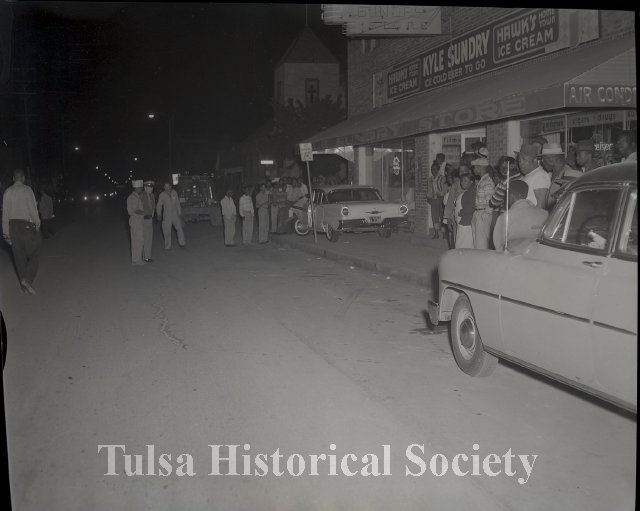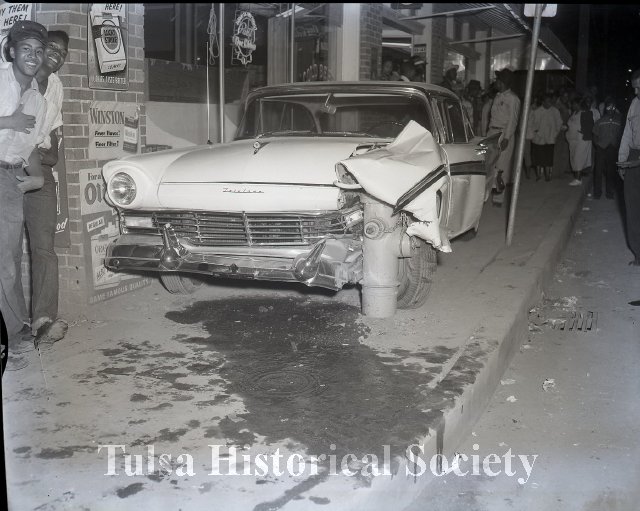Greenwood's Kyle Drug Store, the Rumble Fish pet store
This is the story of a building in Tulsa's Greenwood District that rose from the ashes of the Tulsa Race Massacre, housed a successful pharmacy, became a beloved malt shop, served briefly as a neighborhood co-op grocery, saw its share of burglaries, robberies, and violence, suffered an ignominious old age, and finished its life as a location in a beloved cult film based on a book by a local author, before its final destruction at the hands of city officials, backed by federal funds, after a mere six decades of existence.
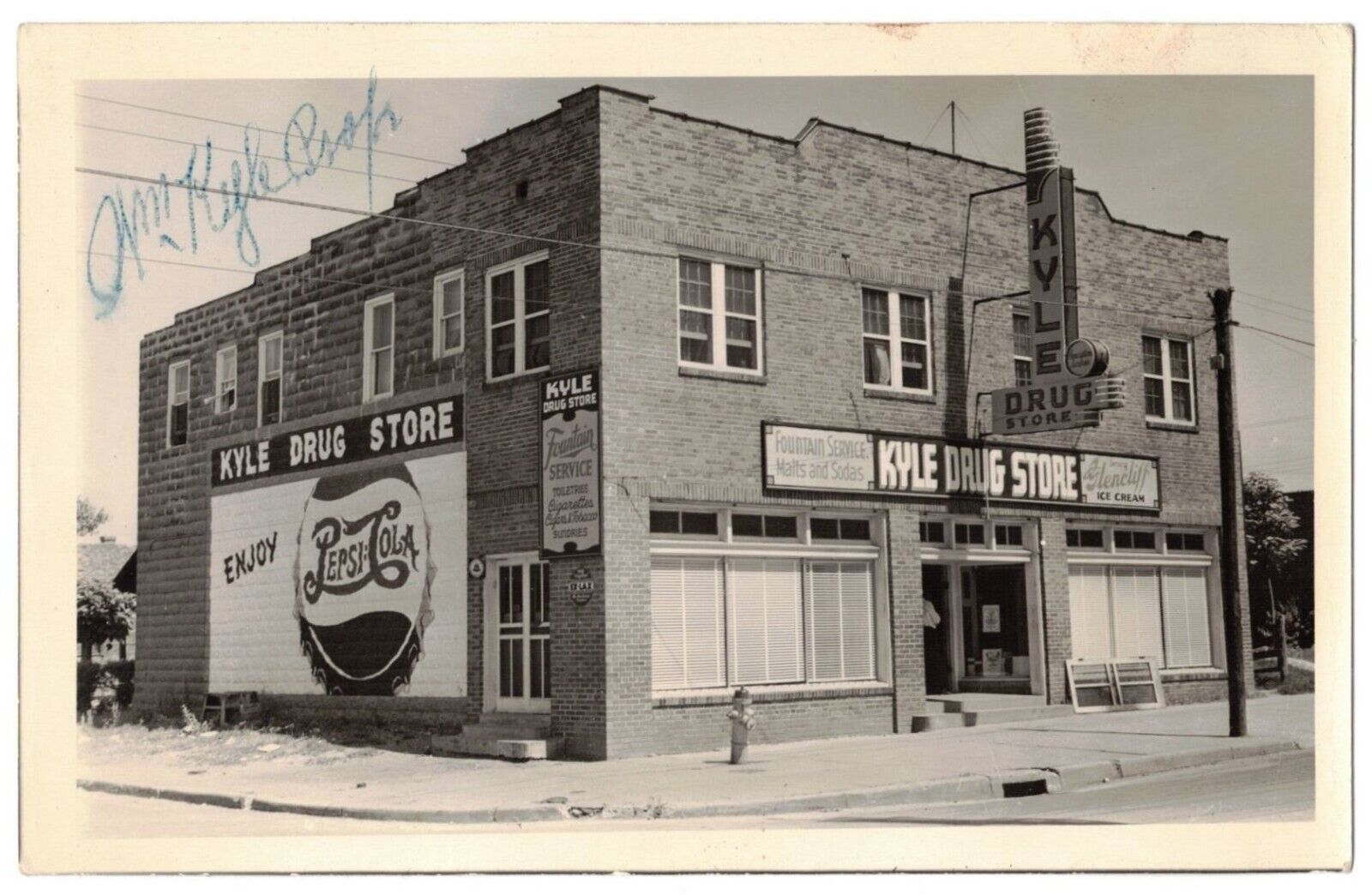
Danny Boy O'Connor reports on the discovery of a foundation stone from a demolished commercial building on Greenwood Avenue. The building, on the southeast corner of Greenwood and Latimer Street, was used by director Francis Ford Coppola as the pet shop in the movie Rumble Fish, based on the novel by Tulsa's S. E. Hinton. The stone will be moved to the Outsiders House for preservation:
You're looking at an 8-foot concrete footing, left buried on Greenwood from the original buildings featured in Francis Ford Coppola's Rumble Fish, based on S.E. Hinton's classic novel and filmed in Tulsa in 1982. I discovered this hidden piece of history a few years ago while searching for historic filming locations. I immediately thought the site would be a perfect location for a future museum. As fate would have it, I later met with Kimberly Johnson, CEO of the Tulsa City-County Library. To my surprise, this very site was the planned location for her new library in North Tulsa. I shared the story with her, explaining that a piece of cinematic history lay buried beneath the surface. I asked for permission to recover it for a future exhibit or museum, and she graciously agreed to let The Outsiders House Museum preserve it. Today was a good day! I can't thank Nathan Tuell and the team at Nabholz Construction enough for carefully digging out the footing and loading it onto our trailer. Huge thanks as well to Gary Coulson from The Outsiders DX in Sperry, Oklahoma, for helping transport and store it. And, of course, my deepest gratitude to Kimberly Johnson for making this dream a reality--allowing us to save the last remaining piece of the Rumble Fish pet store location. P.S. Thank you, Patrick McNicholas, for the reference photos and the photo mashes.
Rumble Fish and its locations inspired Chilean author Alberto Fuguet to visit Tulsa and then to create a documentary about the experience: Locaciones: Buscando a Rusty James (Locations: Looking for Rusty James"), which was screened at Tulsa's Circle Cinema in 2014.
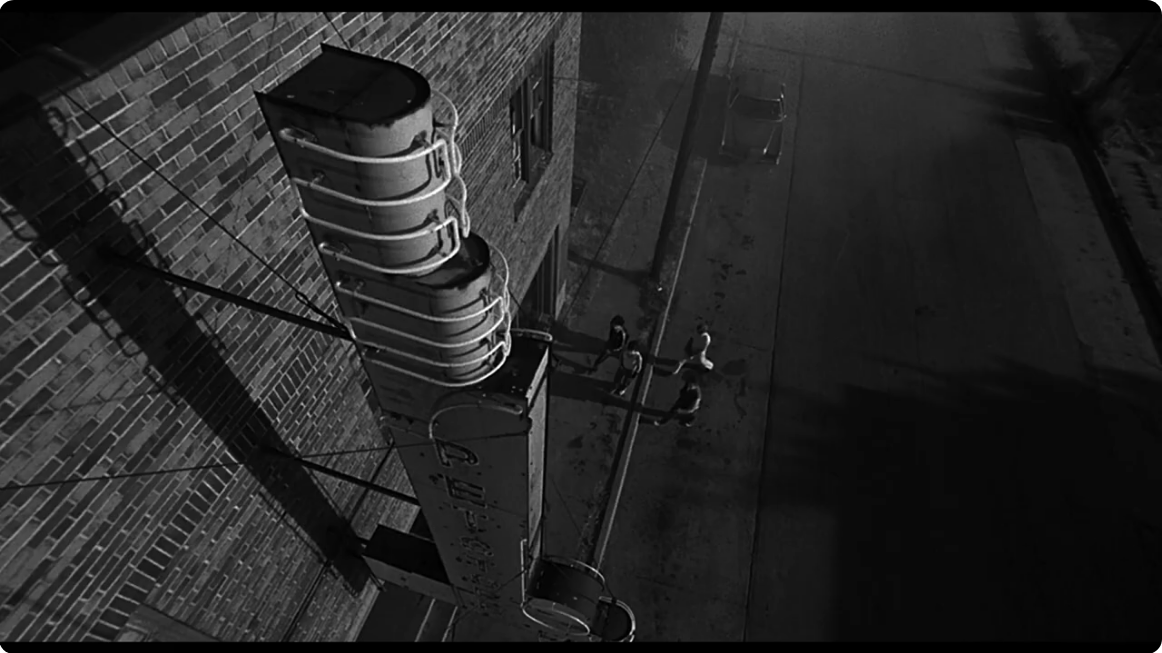
The pet store location was a two-story retail building on the southeast corner of Latimer St and Greenwood Ave. The 1957 Polk City Directory says that Kyle's Sundry was at 1023 N. Greenwood, and the Kyle Apartments were upstairs at 1023½. This was one of the last surviving bits of a commercial area on the north end of Greenwood Avenue between King Street and Pine Street. Sometimes called Upper Greenwood, the area was considered more family-friendly than Deep Greenwood, at Archer. Many of the buildings, like this one, were two stories, with rooms to rent on the 2nd floor. There were a number of churches here, a movie theater (the Rex, just two blocks away at 1135 N. Greenwood), groceries, cafes, barber shops, and pool halls. The area was cleared as part of the City of Tulsa's urban renewal program. This sort of retail building, and the idea of having retail next to residential, was considered "obsolete" and "blight" by urban planners of the day, so it was demolished at some point in the mid-1980s.
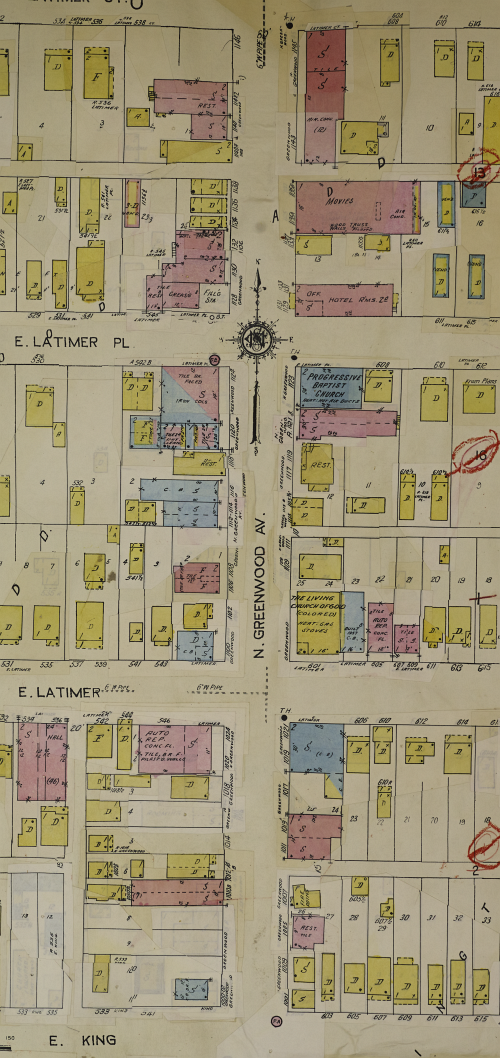
Here's a link to the 1962 Sanborn map for this part of Greenwood, between Jasper St and Latimer Court, the same area in 1939, and here is the section of Greenwood just to the north between Marshall and Pine.
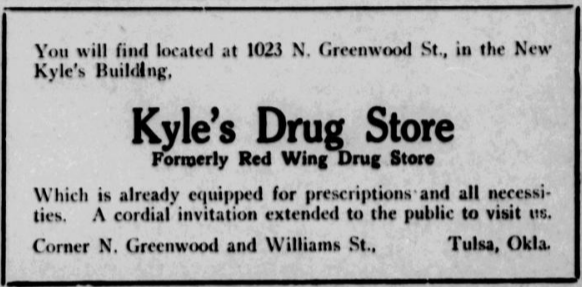
Kyle's Drug Store (formerly Red Wing Drug Store) opened in the new Kyle Building at 1023 N. Greenwood in August 1921, just two months after the Tulsa Race Massacre destroyed much of the neighborhood. The Oklahoma Sun reported:
The editor recently visited the Kyle building at the corner of N. Greenwood and Williams Streets, and found that the Kyle Drug Store was being operated in same. This building has 18 rooms -- two large store rooms on the first floor, and 16 rooms on the second, the upper story will be used for offices and sleeping apartments. The building is modern and one of the largest to be erected since the riot. It is an ideal section, and we are confident that the drug store, etc., will be a decided success. Dr. R. W. Motley was busy arranging his suite of rooms while we were there.
(Here is the same article on the free Oklahoma Historical Society newspaper archive. The front page of that issue has an editorial calling for reparations for the riot and compensation for any plan to convert Greenwood into an industrial district.)
A 1929 business directory lists three Kyle Drug Stores locations: 202 N. Greenwood, 1023 N. Greenwood, 1351 N. Lansing.
In 1927, an 18-year-old clerk sleeping in back of the store foiled an early morning burglary by shooting one of the two crooks. The store was held up in 1934 by a man with a basket over his head. The lady proprietor shot at him and missed, but the bullet went into a house and grazed a woman three blocks away at 539 E. Oklahoma Place. Mrs. Kyle was robbed again in April 1939: A pair of bandits demanded beer, looted the cash register, a marble machine, and a juke box. A number of other burglaries and robberies made the newspaper over the years.
A November 30, 1934, listing of Tulsa drugstores selling Colgate Palmolive products mentions Kyle Drug Stores at 126 and 1023 N. Greenwood. Only one Kyle Drug Store, at 1023 N. Greenwood, is listed in this 1944 list of Tulsa pharmacies carrying Pso-Risidal.
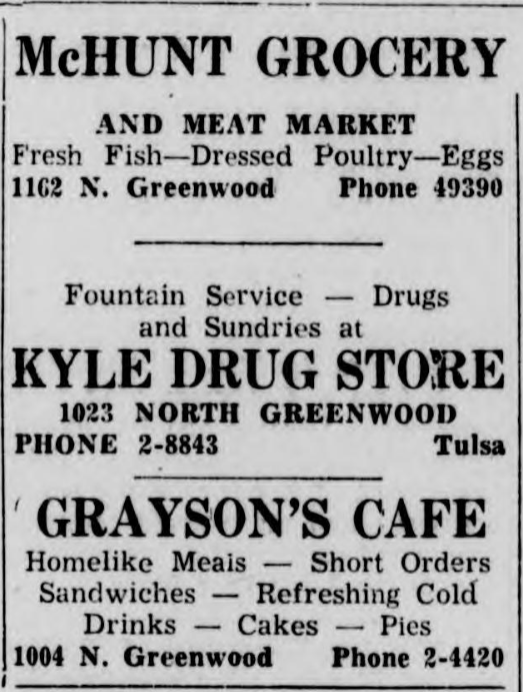
The drug store had a mezzanine, and in 1938 it was used as a meeting place for the Negro Women's Precinct Democratic Club.
On April 16, 1939, William W. Kyle, 19, the son of pharmacist William Kyle, was one of five Booker T. Washington High School students killed while driving back from a Hi-Y conference at Langston. The car was trying to pass a truck on Route 66 11 miles east of Bristow, lost control, and struck a tree. 3,000 people gathered in the Tulsa Convention Hall for a joint funeral service the following Friday.
In May 1941, William Kyle was sued by Rosa Davis, who claimed he incorrectly filled a prescription, which made her violently ill, leading to an operation. The court appointed a chemist to do an analysis. The case was dismissed in October 1941.
Kyle's Drug Store was described as follows in a business profile page in the August 15, 1942, Oklahoma Eagle:
This business has been continuously in operation since 1921, and a complete line of drugs, sundries, haberdashery, beer, cold drinks, ice cream, confections, notions, etc., is carried, with special facilities for filling prescriptions.
Pharmacist William Kyle died on June 7, 1950, at the age of 69. His widow Hattie and son Nanse continued to operate the store for a few years. The obituary for Dr. Kyle says that Kyle Drug was the largest drug store in North Tulsa. The family lived at 2203 N. Peoria. Kyle's service was held at Wesley Methodist Church, and he was buried at Crown Hill cemetery. (The same edition of the Eagle reported that Robert Bell -- later of Bell's Amusement Park fame -- installed a 12-person miniature train at Lincoln Park. Nine cents bought six trips around the hundred-yard track.)
On September 14, 1953, Roy Johnson purchased the drug store from the Kyle family. He continued to operate Kyle's Sundry until Johnson's death on January 19, 1969. Johnson was on the board of Hutcherson YMCA, a member of Vernon AME, and very active in the community. His son Roy Johnson, Jr., as an editorial director for Vanguarde, published the African-American Heritage Tour Guide in 2002.

In a reminiscence about delivering newspapers in the Greenwood District from 1957 to 1961, Dr. Stewart Gilbert remembers Kyle's Sundry from this period:
A special treat between Sunday school and church service was a malt at Kyle's Sundry, which was across the street from the Church of the Living God at Latimer Street.
I imagine Kyle's Sundry was much like the late lamented Steve's Sundry at 26th and Harvard, a drug and variety store with a soda fountain and lunch counter but without a pharmacy.
One notable resident of the upstairs rooms at 1023½ was Jake Ramsey, a minister who reported his memories of life in early Tulsa (he arrived in 1898) in a 1955 Tulsa Tribune story. He had been a porter, a shoe shine, and a justice of the peace in his long career.
Edward Williams, long-time Sunday School superintendent at Wesley United Methodist Church from the 1930s to the 1970s, was an employee of Kyle Drug for 15 years.
Roy Johnson was named as one of many unindicted co-conspirators in a 1957 federal bootlegging trial, "linked to policy game operations." Johnson testified to the federal grand jury. (A 1943 Tribune article compared the weekly jackpot drawing run by the Dreamland movie theater on Greenwood to a policy racket. The article mentions an editorial condemning the theater lottery by Oklahoma Eagle publisher Ed Goodwin; it appears under the byline "Herman B. Ware.")
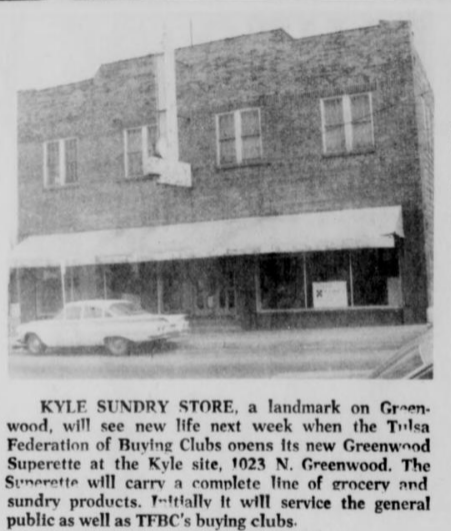
In 1969, Kyle's Sundry was to become a co-op grocery. Choice for Tulsa, part of the Model Cities initiative, funded by federal grants, and led by Wallace B. "Bud" Poteat, was attempting to redevelop retail in urban renewal areas. The Buying Clubs began in December 1967 as a weekly order-and-pickup system, but within a year, grocery store operations were set up.
A story in the April 25, 1969, Tulsa World states that two "superettes" of six planned were already in operation, one at 522 N. Greenwood and the other, nicknamed Guadalupe, at 1238 N. St. Louis Ave.
The second unit is nicknamed "Guadalupe" by staff members because it serves mainly Indian and Mexican-Americans in the area of Our Lady of Guadalupe Roman Catholic Church. It is expected to be self-sustaining by Sept 1.It will maintain stocks of groceries and sundries, offered at low prices through group buying. It will specialize in Mexican food items.
The store on Greenwood will be moved to the former location of the Kyle Sundry Store, 1023 N. Greenwood Ave. Loss of this outlet because of the death of the proprietor has proved an inconvenience to residents of the area, Poteat said.
This store will offer sundries, groceries, and an ice cream fountain. Poteat and Choice staff members estimate the expenditure to open this store will be $12,050; for the Guadalupe outlet, $3,000.
In 1941, 1238 N. St. Louis was Ogle's Grocery, one of dozens of tiny neighborhood grocery stores in Tulsa. In 1945, the place, belonging to David Lazano, was raided for suspicion of beer above the 3.2% alcohol-by-weight limit. Here's that location as captured by Google Street View in 2012:
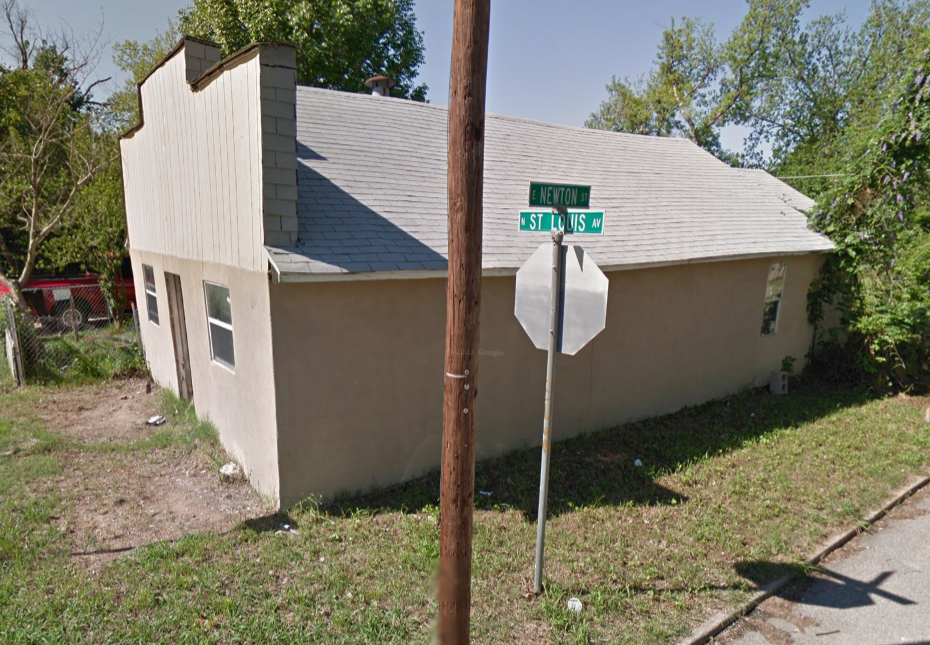
The September 4, 1969, World reported that the Tulsa Federation of Buying Clubs was attempting to sell $25,000 in bonds to fund the renovation and relocation, which evidently had not yet happened, as well as additional superettes and furniture stores. (Here's the Oklahoma Eagle report on the bond issue.)
The federation, which operates two stores, is a delegate of the Tulsa Economic Opportunity Task Force. The stores provide food, sundries and drugs to the poor by large master orders. The stores pass savings along to buying club members. The drive began July 1, but support was slow during the summer because organizations did not meet and therefore could not be contacted, Poteat said. A full schedule of meetings and speeches is planned for September, however, and support has picked up during the last week, he noted.Money from the bonds is being used to relocate a Buying Club grocery, formerly at 522 N. Greenwood Ave., to 1023 N. Greenwood Ave., and to refurbish what was Kyle's Sundry store. More items will be offered in the larger store, and meat and produce counters will be added.
Previously, meat was available to club members only once a week. Although group club orders still will be delivered to each club once a week, members may purchase meat through individual orders at any time, as the meat choices will be available daily. The new facility will be opened for business next week, Poteat said, with the grand opening scheduled for late September or early October. The other Buying Club store is at 1238 N. St. Louis Ave.
In 1971, federal auditors questioned almost $13,000 spent by the Tulsa Federation of Buying Clubs in 1969-1970. The Greenwood store is mentioned but not the Guadalupe store. That same year, Rev. B. S. Roberts was named chairman of the Federation; in 1990 Roberts would become the first Tulsa City Councilor for District 1.
In November 1972, a girl was born at St. John's Hospital to Mr. & Mrs. Fred Renfro of 1023 N. Greenwood. In 1968, Fred Renfro had been slashed by a knife-wielding attacker when he opened the door of his home at the Kyle building.
On June 14, 1972, it was reported that a Federal tax lien was placed against the Greenwood Buying Club store for $2,394 in income tax and FICA. Release of the lien was reported on March 30, 1974.
On April 23, 1974, when the USDA banned the Tulsa Federation of Buyers Clubs, operating at that location, from participating in the Food Stamps program. The store was accused of allowing recipients to exchange food stamps for cash.
On December 16, 1978, Billy Ray Cochrane, who lived nearby at 635 E. Latimer Place, was fatally wounded in a shootout in the ABC Bar at that location, which had a reputation for violence. Ads for the ABC Private Club show up starting in 1975.
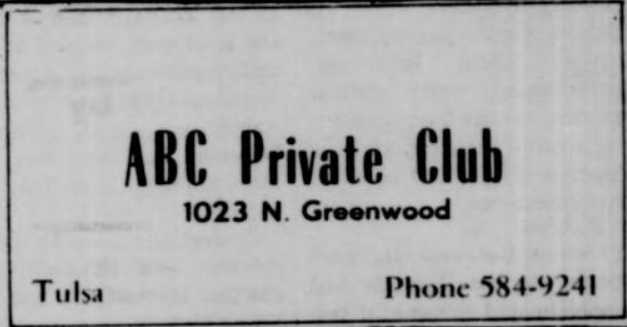
A 1983 Tulsa World article listing some filming locations used in Rumble Fish is the last newspaper mention I've found of the 1023 N. Greenwood address.
William Kyle bought the land in the new Washington Addition in 1919 (Book 285, Page 241, recorded December 4, 1919). Katie Duckery sold an adjacent property to the south to William and Hattie Kyle on June 3, 1939 (Bk 1485, Pg 219). On December 31, 1954, Hattie, now widowed, sold the property to Roy and Ida Mae Johnson (Bk 2528, Pg 574, 575). Tulsa Urban Renewal Authority acquired the residential lots on the block in 1974, but the Johnsons' property, now owned jointly by Ida Mae, her new husband, and her two sons, was transferred to TURA in three general warranty deeds (Bk 4805, Pg 2450-2452) in July 1984 and then a District Court final decree on September 26, 1984 (Bk 4819 Pg 204). At some point later in the decade, the land was transferred to the University Center of Tulsa Authority for a college campus that never needed the space, then (according to assessor records) to Oklahoma A&M Board of Regents in 2018, then to the Tulsa City County Library Authority in 2022.
MORE:
Postcard of Kyle's Drug Store found at Worthpoint.
Display ad for Kyle Drug Store clearance sale, June 25, 1953
Display ad for Kyle Sundry Store grand opening, September 17, 1953
Reader Paul Uttinger sent along two photos from the Tulsa Historical Society of a May 6, 1957, car wreck on the sidewalk in front of Kyle's Sundry. A Ford Fairlane ran onto the sidewalk and into a fire hydrant. Notice the tower of the Church of the Living God in the background of the first photo. The neon on the sign has been changed from "DRUG" to "SUNDRY." The young men on the left of the second photo seem to be having a fun time.
0 TrackBacks
Listed below are links to blogs that reference this entry: Greenwood's Kyle Drug Store, the Rumble Fish pet store.
TrackBack URL for this entry: https://www.batesline.com/cgi-bin/mt/mt-tb.cgi/9332
